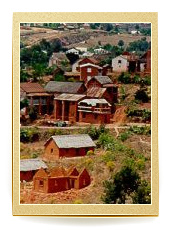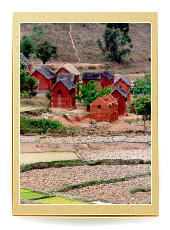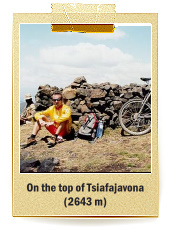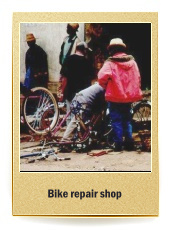Tsiafajavona
The second part of the expedition would have started awfully, if it hadn't been for friar Roman from the Oblates congregation. He took his car and I followed him to the outskirts of the city, from where there was only one road heading south. I don't think I would have reached this place without his help. The overwhelming tangle of roads in Antananarivo is characterised by a total lack of road signs. However, before I got out of the capital city, I had to struggle with a massive traffic jam in front of one of the bridges. Even though it was 7 am, the traffic was very dense. Finally I left all this hustle and bustle behind, and took a deep breath. The landscapes I saw were quite different from what had surrounded me during the previous two weeks.

 Houses erected on the plateau were more solid, made of red brick. Speaking of bricks – they are hand-made using clay from rice fields. Sun-dried bricks are then stacked in piles over a hearth where charcoal is burnt – the only fuel available in Madagascar.
Houses erected on the plateau were more solid, made of red brick. Speaking of bricks – they are hand-made using clay from rice fields. Sun-dried bricks are then stacked in piles over a hearth where charcoal is burnt – the only fuel available in Madagascar.
Leaving aside a few litres of sweat lost in the 40°C heat, I had no difficulty in covering the 70 km distance to Ambatolampa, although the lack of any shade was troubling me again. Unlike at the beginning of my journey, rice fields no longer made such an impression on me. However, when I saw two cyclists sitting by the road, my heart did beat faster. They were a married couple from Belgium, on the third day of their touring bike trip. As an 'old trouper', I gave them some advice, first of all not to risk exploring unreliable side roads.
In Ambatolampa there was an excellent hotel run by an American married to a Malagasy lady. In the evening I detached all redundant things from my bicycle (i.e. the luggage racks) in order to prepare myself for the next day. I decided to reach the third highest peak of the island – Mount Tsiafajavona (2643 m). At the beginning I couldn't learn how to pronounce the name correctly, but eventually 'chafajoonah' stayed in my memory.
Here I would like to add a few remarks about the Malagasy pronunciation and nomenclature. 'O' is pronounced as 'u', 'y' as 'i', and 2 out of every 3 village or town names begin with the prefix 'Antana-'. Interestingly, all men's names begin with 'R'.
Coming back to the journey itself – I woke up at 6 am, when the Sun was just rising above the hills. After stuffing into my backpack some food, water, clothes and my 'MacGyver's set', I dashed away on the two-wheeler. I found myself on a laterite-covered track, and after cycling for a few kilometres I had no idea which way to go at the crossroads. Some locals told me to turn left, so I cycled uphill. After climbing for several kilometres, however, I noticed something was wrong. I can't complain on my sense of direction, and it told me that I was cycling away from the mountaintop. The map confirmed my suspicions, so I went back to the crossroads. The locals had already been gone, but I managed to find the right way by myself. The climb was both easy and tiring. Easy – because the road was in good technical condition, properly maintained like good mountain tracks. Tiring – because it was very steep, and my backpack weighed a lot. Slowly but steadily I was moving uphill. At around 2300 m above sea level the road became bumpy and I had to walk the bike for several hundred metres. Afterwards, luckily, it was nice and flat all the way to the top. Moreover, the sights that I could admire were simply breathtaking! For the last one hundred metres I had to climb up a nasty slope, carrying the bicycle on my shoulder. On the top of this sacred mountain there was a stone altar on which animals were sacrificed. I even saw spots of fresh blood. I was quite surprised to see a Malagasy man there, who climbed the mountain barefoot. Peculiar.

It took me some time to recharge my batteries after the demanding climb. It was 1 pm already, so I had to turn back. Cycling downhill was an incredible experience! I went as fast as 65 km/h, jumping over drainage ducts sticking out of the ground. I was without a helmet on my head (do not try this at home!) and adrenaline was pumping through my veins. That's how I like it!!! The shock absorbers worked perfectly well, but in the meantime I lost my water bottle. I went back up to look for it, but it was gone forever. Bad luck. After coming back to the village I had a solid meal in an inn. I was hungry like a wolf, my backpack food supply being long gone. And the delicious Malagasy beer… just heavenly! After lunch it was time to sit somewhere in the village centre and feed my camera with a dozen of nice snapshots.




